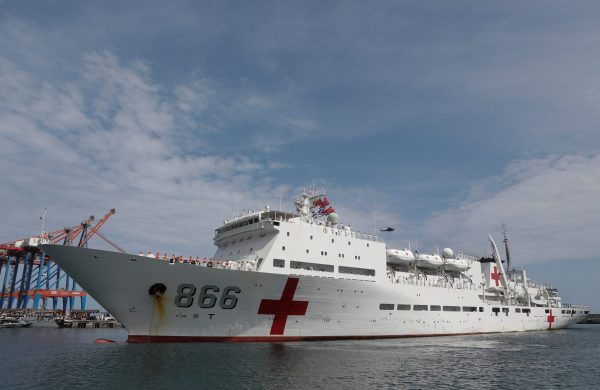The ship, also known as Daishan Dao, is now headed towards a few Central and South American countries.
This is the seventh year of Peace Ark’s ‘humanitarian mission’. So far, the ship has visited 37 countries where doctors on board have provided humanitarian medical services for more than 180,000 people. The offshore hospital ship is said to have 120 medical staff working in 18 clinical departments and five auxiliary ones. The ship also has 300 beds for patients, eight operating rooms, 20 intensive care units and even a heli-ambulance.
The idea of building Peace Ark was conceived in the 2000s when China was eager to develop and expand its soft power. This was arguably because China was well-equipped with hard power but realised soft power is the way to build its image which otherwise was rooted in deep suspicions about authoritarianism. Peace Ark’s humanitarian assistance over the past few years has not only helped Beijing successfully win praise from other countries, but also assisted the promotion of Chinese culture and enhanced people-to-people exchanges. For instance, in its recent visit to Tonga, Chinese sailors held cultural activities with teachers and students from Tongan schools. They also held a friendly football match with counterparts from the Armed Forces of Tonga.
For many years, China‘s approach to building its soft power has focused on financial support for socio-economic development in underdeveloped countries, in addition to massive cultural and language programs undertaken by institutions such as the Confucius Institute. Some observers have been impressed while others are concerned about China’s provision of funding for local infrastructure and economic development projects in Africa, South America and parts of Asia.
Either way, Beijing is poised to continue to use its financial resources for the purpose of building closer political and social ties with other countries. In September 2018, for instance, President Xi Jinping pledged US$60 billion in aid and investment to African countries at the 2018 Forum on China–Africa Cooperation.
Yet China’s provision of humanitarian assistance has been neglected by many observers of the country’s soft power. Peace Ark is instrumental in enhancing China’s soft power because its missions are receptive to most countries. For instance, the medical assistance of Peace Ark mission has won praises from the Prime Ministers of Tonga and Papua New Guinea. The fact that the Peace Ark ship is welcomed in countries like Fiji for the second time is another case in point. As the Chinese Foreign Ministry spokesperson Lu Kang said that Peace Ark’s assistance to other countries is China’s way of promoting international humanitarianism and practicing peace, development and cooperation.
China’s use of Peace Ark for soft power purposes does face challenges. It has been observed that China’s foreign policy objectives sometimes drive its decisions to provide humanitarian aid. For example, when the Philippines was hit by Typhoon Haiyan in 2013, China sent Peace Ark to provide aid only after it was criticised for delaying assistance due to disputes with the Philippines over the South China Sea. Another controversy surrounds China’s refusal to deploy the humanitarian aid ship to countries that maintain official relations with Taipei.
Peace Ark is certainly a means to enhance China’s soft power. The underlying economic and political interests behind the ship must not be ignored. Not only is Peace Ark’s deployment selective but its docking locations are too. A previous stopover in Puntarenas, Costa Rica was a tactical choice to gain access to finite resources such as oil refineries. The hospital ship’s missions strengthen people-to-people relations but deployments are ultimately an avenue to increase economic opportunities and gain political advantages. It also gives China access to various countries’ naval bases which would be difficult to access otherwise.
China will undoubtedly continue to use Peace Ark and other aid programs to enhance its soft power in other parts of the world. This is clearly demonstrated in its plans to carry out humanitarian activities and other forms of assistance, such as crisis and disaster relief, in countries associated with the Belt and Road Initiative. These humanitarian programs are poised to help serve not only China’s soft power, but also its regional geopolitical objectives.
Atmakuri Lakshmi Archana is a research associate at the S. Rajaratnam School of International Studies, Nanyang Technological University, Singapore.
Mingjiang Li is an associate professor at the S. Rajaratnam School of International Studies.


It would be interesting to know what other countries provide such assistance, including similar vessels and also equivalent assistance such as visiting medical teams. Perhaps a topic for a follow up article.